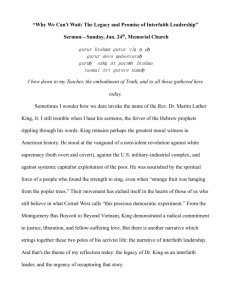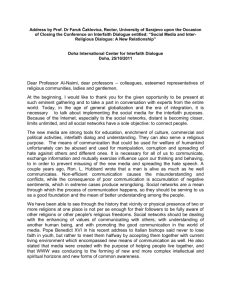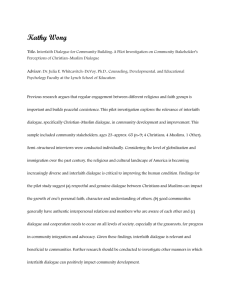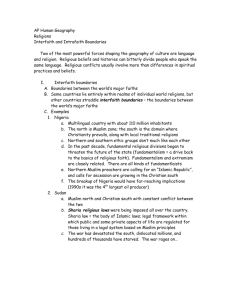O. Leirvik. Christianity and Islam in Norway: Politics of Religion... Canadian Diversity 2005, vol 4(3), pp 7-10.
advertisement
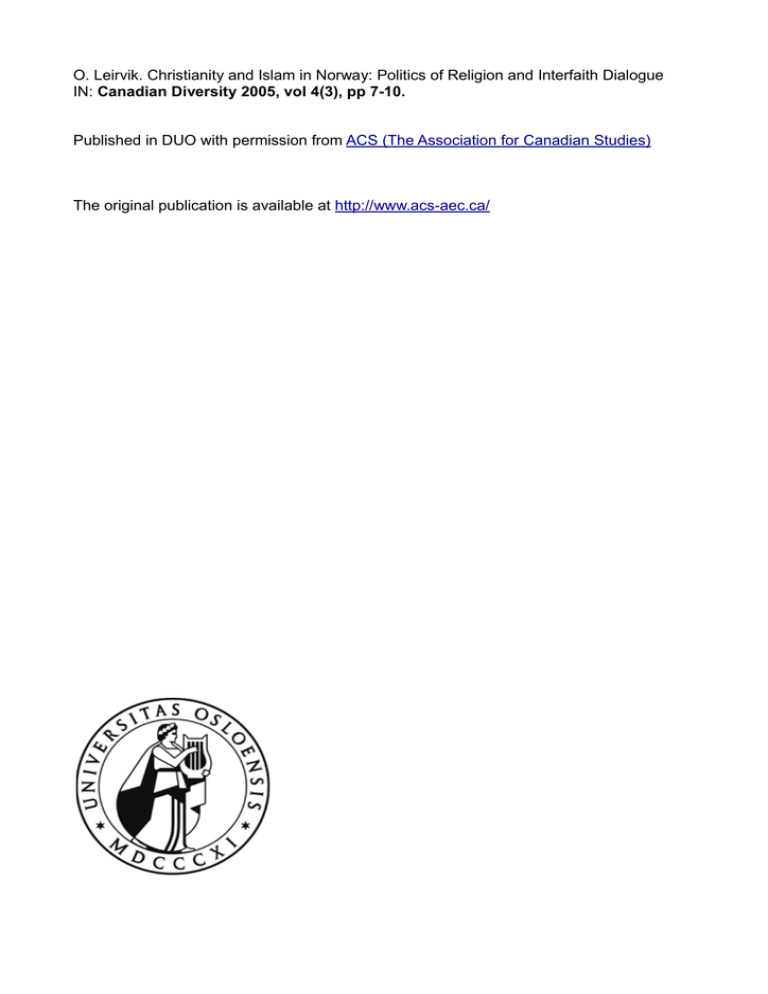
O. Leirvik. Christianity and Islam in Norway: Politics of Religion and Interfaith Dialogue IN: Canadian Diversity 2005, vol 4(3), pp 7-10. Published in DUO with permission from ACS (The Association for Canadian Studies) The original publication is available at http://www.acs-aec.ca/ Christianity and Islam in Norway: Politics of Religion and Interfaith Dialogue 1 By Oddbjørn Leirvik, Associate Professor in Interreligious Studies, Faculty of Theology, University of Oslo Printed in Canadian Diversity 3: 2005, pp. 7-10. The context of the following reflections on Christian-Muslim relations and interfaith dialogue is the state church situation in Norway. During the last few decades, the state church system has been in a process of adjustment to a pluralist, multireligious reality. It has been modified by institutional reforms aimed at church autonomy, and by compensatory measures meant to balance those aspects of the system that would otherwise be discriminating against other faiths. With regard to finances, compensatory measures were introduced in 1969. Since then, every faith community (including Muslim) which registers itself has been entitled to exactly the same amount of money per member as the Church of Norway receives per capita in financial support from municipal and national budgets. During the 1990s, various forms of interfaith dialogue evolved, and were also to some extent institutionalised. In 1996, an interfaith Council for Religious and Life Stance Communities in Norway was formed, as an NGO- initiative. In 1998, the Council established the Oslo Coalition on Freedom of Religion or Belief, in which representatives of the faith communities engage each other and international partners on issues pertaining to religious freedom and interfaith cooperation. In such multilateral forums, Muslims participate on a par with representatives of the other faiths. In addition, since 1993, there is a bilateral Contact Group for the Church of Norway and the Islamic Council in Norway. While the faith communities have engaged each other in dialogue and cooperation, popular political discourses often point in a different direction. Revealing an increasing tendency to reaffirm the so-called Christian cultural heritage as the uniting bond of the Norwegian nation, ‘Christian and humanist values’ have been invoked as the foundation of its public institutions. Parallel to these communitarian tendencies on the part of the national religion, the Norwegian state has also pinpointed some universal concerns and challenged both the national church and the faith communities in such matters as freedom of expression, interreligious tolerance, women’s rights and the rights of children. THE RELIGIOUS SCENE IN NORWAY 1 A longer version of this article has been Printed in Jamal Malik (red.): Muslims in Europe. From the Margin to the Centre. Münster: LIT Verlag 2004, pp. 101-114. Cf. also Oddbjørn Leirvik: "Islam and ChristianMuslim Relations in Norway. Popular realities, political and religious responses, interfaith cooperation", Islamochristiana vol. 29, 2003, s. 121-140. 2 In spite of a steady reform process that has made the dominant Church of Norway more autonomous, Norway remains a state with a religion. Paragraph 2 of the Norwegian constitution runs as follows (in my translation): ‘(1) All inhabitants of the kingdom shall be free to exercise their religion. (2) The Evangelical-Lutheran religion remains the public religion of the state. Inhabitants confessing this religion, are obliged to raise their children in the same.’ The second part originates from 1814, the first part was added in 1964. Formally, the King is formally the head of the Church, and half of the members of government are still required to be Lutheran Christians. Only in 1989 was the appointment of clergy delegated to independent church bodies. But the state has retained the final say in the appointment of bishops. More than 90% of the population, which amounts to a total of 4.5 million, is formally Christian. Eigthy-six percent belong to the Lutheran state church, which in financial terms remains fully integrated into municipal and state budgets. The Catholic and Pentecostal churches each constitute 1% of the population, the other free churches some 2% altogether. Given the fact that only about 10% of state church members are regular church-goers, on the level of activities there is more of a balance between the Church of Norway, the Catholic church and the free churches. Apart from the high percentage of state church members, two salient features of organised religiosity in Norway can be cited. One feature is non-religious: Norway has got an exceptionally strong secular Humanist Association which offers a non-religious framework for morality and ceremonies. Only 1.5% of the population are members, but their influence is disproportionate to their number. Secondly: a high percentage of resident Muslims in Norway have signed up for membership in Muslim associations. According to estimates from 2004, Norway had about 115 000 (permanent or temporary) inhabitants of a Muslim background, which means that Muslims make up about 2.5 % of the population. The major countries of origin are Pakistan, the Balkans, Iraq, Iran, Somalia, Turkey and Morocco. The total number of those with a Muslim background is smaller than in either Sweden or Denmark, but their level of organisation is higher. In 2004, 70% of people of Muslim origin in Norway, including children, were members of a mosque or Muslim association. It should thus be noted that the relatively high degree of organisation reflects the decision of the parents, and not necessarily salient trends among Muslim youth. Organised plurality and migrating souls In the aforementioned interfaith council, formally elected representatives of the state church, the other churches, the Islamic Council, the Buddhist Association, the Jewish community, the Bahá’í faith, the Hindu community, the Humanist Federation and the so-called Alternative Network sit together and conduct their business on a principle of consensus. The fact that the nonconfessional Alternative Network is part of the interfaith council points to another important aspect of multireligious Norway. Along with a well-organised plurality of faith communities, there are also many ‘migrating souls’ who may be less loyal towards their faith communities than what their formal affiliation might indicate. In particular, this is true of state church members, many of whom form their identity quite freely and nourish themselves from a multitude of spiritual sources. Religious individualism also affects Norwegian Muslims. Firstly, they have a great number of institutional, Islamic identities to choose from. As in many other European societies, all major Islamic trends and a wide array of Muslim transnational organisations are represented, together with indigenous, youth- or women- 2 3 based organisations of the Euro-Islam type. Secondly, many of the younger generation construct plural identities in which ‘Islam’ is but one out of many flexible elements. 2 Bearing in mind the fact that among first generation immigrants, the cultural (e.g. Pakistani) part of the identity may be stronger than the religious part, one will always have to raise the question of exactly which ‘Muslims’ and which ‘Christians’ we are referring to when addressing Christian-Muslim relations. POLITICAL RESPONSES TO ORGANISED PLURALITY Government responses to the multireligious situation, which is still felt as a new challenge in Norway, have been varied. In what follows, I shall distinguish between (a) what I term statesupported, Christian communitarianism; (b) a politics of recognition affirming the rights of communities; and (c) universalist oriented policies focused on individual rights. (a) State-supported, Christian communitarianism In the field of education, some analysts have identified the emergence of a kind of state-supported communitarianism on the part of a liberal version of Christianity. When a political alliance of the Social Democrats and the Christian Democrats introduced a new and mandatory subject of religious education in 1996-97, this replaced a previous system of multiple choices between (1) Christian education, (2) a Life Stances-alternative (which was introduced in 1974 after secular humanist lobbying) or (3) no religious education at all. The new subject was given the cumbersome and revealing name ‘Knowledge of Christianity with Information about Religion and Life Stances’. In 2002, the name was modified to the slightly less hiearchical ‘Knowledge of Christianity, Religions and Life Stances’. 3 Not surprisingly, many minority representatives felt that the initial title of the subject was discriminating and overly self-affirmative on the part of Christianity. This impression was strengthened by formulations in the general part of the reformed curriculum of which the new subject was but one part. Here, under the heading of ‘Christian and Humanistic values’, it was stated that ‘Christian faith and tradition constitute a deep current in our history – a heritage that unites us as a people across religious persuasions’. Adding a reference to humanism, ‘Christian and humanistic tradition’ were referred to as ‘interwoven’. 4 In order to understand minority resistance to the new subject, it should also be noted that primary schools in Norway have a Christian objects clause. The Education Act still states that ‘primary school is supposed to help in giving the pupils a Christian and moral upbringing ...’. This, of course, sheds additional (and indeed traditional) Christian-communitarian light on the new subject of Christian and religious education. Since the new subject is nevertheless meant to be inclusive, only partial exemption is granted. Although a major aim of the new subject has been to create a space for interreligious learning and interfaith dialogue in school, many Muslims and secular humanists have seen the new subject as a kind of state-supported Christian communitarianism. The Islamic Council and 2 See Sissel Østberg: Pakistani Children in Oslo. Islamic Nurture in a Secular Context. Leeds : Department of Theology and Religious Studies, University of Leeds, 2003. 3 An English version of the curriculum can be found in The Curriculum for the 10-year Compulsory School in Norway. Oslo: The Royal Ministry of Education, Research and Church Affairs, 1999, p. 95ff. 4 The Curriculum for the 10-year Compulsory School in Norway, p. 23. 3 4 the Humanist Federation have both sued the state for having eliminated the right to full exemption, and hence the right to establish alternatives. 5 In 2004, the United Nations’ Human Rights Commission criticised the Norwegian government for having taken away the right to general exemption from a subject that was seen by the Commission as privileging the Christian tradition. 6 If one reads the general aims of the new subject, one may detect a mixed influence from communitarian and universalist thought. The first aim (according to the revised 2002 curriculum) is to make all pupils ‘thoroughly acquainted’ with the Bible and with Christianity – both as a ‘cultural heritage’ and as a ‘living source of belief, morality, and view of life’. In the second aim, it is stated that all pupils shall also be introduced to other world religions and life philosophies as ‘living sources of belief, morality, and views of life’. The third aim is to make them all ‘familiar with the Christian and humanist values on which school education is based’. In the fourth and fifth aims, the subject is presented as an interaction between identity formation and dialogue training: ‘religious and ethical education shall promote mutual respect and dialogue, and stimulate the pupils’ personal growth and development’. What kind of project is this? Is it Christian communitarianism – an attempt to counter postmodern individualist pluralism with some solid knowledge of Christian heritage and values? Or should it be taken as a potentially universalist project which treats all religions on an equal basis as ‘sources of belief, morality and views of life’, with the overall aim of training new generations in dialogue? In both political discussions and pedagogical practice, the new subject has proved to be liable to both interpretations. (b) Politics of recognition, focused on communities The universalist potentials of the new subject could alternatively be taken as a generous kind of communitarianism – in the form of multiculturalism. Four religions (Judaism, Islam, Buddhism, Hinduism) and one particular ‘life stance’ (Secular Humanism) have been selected as major topics along with Christianity and the more universalist theme of ‘philosophy and ethics’. In the initial phases of the planning process, in which the general principles of the new subject were established, neither the faith communities nor individuals representing other religions than Christianity took part. But as a result of protests, more or less representative bodies of the named faiths were eventually invited to suggest how their faiths should be represented in the curriculum. They were also invited to give their comments on proposed textbooks. The eventual inclusion of the faith communities in the formative process could be taken as a hesitant ‘politics of recognition’, which addresses the communal dimension of moral and religious identity. In general, the Christian Democrats have been advocating a politics of recognition more clearly than the Social Democrats. In the Norwegian context, many Christian Democrats have seen themselves as representatives of a conservative counter-culture. This may have made them more fit for a ‘politics of difference’ than the modernist unitary thought typical of the Social Democrats. The way in which Norway has chosen to deal with financial issues in the field of religion goes well with a politics of recognition oriented towards communal rather than individual rights. Instead of refunding individual tax-payers, compensation for state church financing goes to 5 Their cases have been turned down in Norwegian courts, but the Humanist Association has brought the case to the European Human Rights Court in Strasbourg. 6 See http://www.odin.no/ufd/norsk/aktuelt/pressesenter/pressem/045071-990398/dok-bn.html 4 5 organised faith communities, Muslims and secular humanists included. The system chosen must be seen against the background of a strong state church legacy, by which religion continues to be regarded as a matter of communal concern in its pluralist expression too. The same is true of how the Law about equality between the sexes, which was introduced in 1978, is applied. Although state feminism has been a salient feature of Norwegian politics during the last decades, faith communities have been fully exempted from the equality laws’ claims and regulations. In this case too, the religious rights of faith communities have been given priority over the religious rights of individuals (in casu, women). In principle, the Church of Norway is also exempted for the equality law. But since clergy have traditionally been appointed by the state (which still appoints the bishops), state feminism has supplied the national church with female ministers since 1961. Since 1993, two female bishops have also been appointed. But in the case of other faith communities, the state has recognised their right to autonomy in gender politics and renounced any kind of state intervention. The principle of a general exemption from the equality laws’ regulations is, however, debated. Many Social Democrats would like to see compliance with egalitarian principles as a prerequisite for receiving financial support from the state. That would imply setting a limit to the politics of recognition. But exactly where should such a limit be set, if one otherwise accepts that communitarian principles should rule in the politics of religion? (c) Supporting the universal rights of individual believers The lines between communal and individual rights are not easily drawn. Even those who generally advocate a community-oriented politics of recognition would strongly affirm that certain individual rights must never be allowed to be violated by the faith communities. Establishing prohibitions against violence and forced loyalties are sufficient as general examples. In 1995-96, new legislation was enacted against forced marriages and female genital mutilation. None of the faith communities objected to this. Publicly confronting the cultural practices of some of their members, many Islamic organisations and Muslim women’s groups have signalled their readiness to cooperate with the authorities in order to abolish practices that involve force or violence. Opinions may differ about the most efficient way of protecting individual rights. The question may be asked whether individual safeguard should evolve immanently from within cultural or religious groups or whether it should be brought about through extraneous pressure. In the past years, feminist activists have defended the rights of young Muslim girls who have become estranged and have broken with their families. They have also accused the Islamic community of not being serious enough on issues such as forced marriage and female circumcision. Controversial methods like the use of hidden cameras have been employed to “reveal” the real agenda of selected Muslim leaders. Yet others have appreciated that most Muslim leaders have taken a principled stand against forced marriages and female circumcision. However, some from within the ranks of secular humanists have criticised the Muslim leadership for merely idealistically declaring such practices as “un-Islamic” without challenging the cultural face of Islam as practiced by immigrant Muslims. Their argument is that religion and tradition are inextricably linked to each other and that a principled stand against practices such as forced marriages and female circumcision should not simply be viewed as “un-Islamic” but rather constituting an Islamic reality from the viewpoint of and reinforced by the traditions of certain immigrant communities. 5 6 Many Muslims insist that as far as the women’s issue is concerned, individuals should be given priority over group interests. However, on the question of religious education in school, they may maintain a delicate balance between individual and group approaches. As mentioned above, both the Humanist Federation and the Islamic Council sued the state because of the new and compulsory system of Christian/religious education in primary schools. The courts were reluctant, however, to deal with faith communities as bearers of rights. In the question of exemption from religious education, the state institutions (schools, courts) have insisted on dealing with individuals rather than faith communities. The right of exemption applies to parents, not to religious or ideological organisations. The Humanist Federation and the Islamic Council were allowed, however, to represent the protests of named parents. The legal controversy indicates a high degree of conflict surrounding religion in school. Local reports, however, testify to the fact that many minority parents (including Muslims and secular humanists) are relatively happy with the way in which the new subject works in practice. In monitoring minority responses to majority projects, one should therefore never be content with listening to the attitudes of organised communities and their spokesmen. Many members of faith communities have individual opinions that run counter to views expressed by their leaders. In some cases, they may be more liberal than their leaders – as independent believers with plural identities. In other cases, they may hold more conservative views – for instance on behalf of their cultural heritage. INTERFAITH DIALOGUE AND NETWORKING Slowly, Norway is getting accustomed to being a multi-religious society. There are several challenges to be faced, both by the religious majority and by the minorities. From the perspective of the faith communities, a major challenge is the tendency on the part of the majority population to equate ‘Norwegian’ with ‘Christian’ (alternatively ‘Christian-humanist’) values. Although it is not always clear what this would imply (considering the wide array of value positions within the Christian majority population), minorities are apprehensive of a public discourse that is sometimes heavily marked by a distinction between ‘us’ and ‘them’. What could be the role of interfaith dialogue, then, within the larger cultural and political framework indicated above? From the early 1990s to the establishment of the interfaith council in 1996, most of the dialogue projects were initiated by non-governmental organisations or institutions. Some also received funding from the state. Some, like that of the national Contact Group of the Church of Norway and the Islamic Council, were initiated by the majority church. In the Christian-Muslim contact group, women’s concerns have been raised as a shared ChristianMuslim perspective, as documented in a book produced by Christian and Muslim women about ‘Dialogue with and without the veil’. 7 This exemplifies how societal issues can affect interfaith dialogue. In other cases, the initiative has come from the minorities, resulting in a strong focus on minority rights. The interfaith Council grew out of the minority alliance of secular humanists, Jews, Muslims, Buddhists and the Alternative Network at a time when plans were first announced for the new and compulsory subject of Christian and religious education. Only after a year were the churches invited to form a representative body of all major faiths in Norway. In the interfaith council, the Church of Norway does not have the special prerogative of being a state church. It is 7 Anne Hege Grung and Lena Larsen: Dialog med og uten slør. Oslo: Pax 2000. 6 7 just a faith community among many others. All constituents operate at the same level and on a regular basis with each other. Most of the cited interfaith initiatives have taken place on the leadership level. At that level, strong personal bonds have been forged. The first president of the interfaith council was a Pentecostal Christian, the second a Norwegian-born Buddhist, the third a Jew. Their first secretary was a secular humanist. Since 1999, the coordinator of on of the interfaith council’s offshoots, the Oslo Coalition on Freedom of Religion or Belief, has been a Muslim convert – a woman of Norwegian origin who was also elected as the president of the Islamic Council at the end of 2000. As indicated by the cited examples, many of those who have been in the forefront of interfaith enterprises in Norway are Norwegians by birth. A number of immigrant Muslims, Buddhists and Hindus have also taken actively part in national dialogues, and become part of personal networking on the leadership level. The dominance of ethnic Norwegians in interfaith dialogue might imply, however, that such dialogues have not yet been sufficiently rooted in the immigrant communities, who often have a cultural-specific rather than religious (in the normative sense of the term) agenda. Among the general public, inclusive attitudes compete with mounting anxiety towards Islam and Muslims. Among the leaders, the picture might seem to be more harmonious, reflecting a decade of trust-building networking. In cultural and political debates centred on Christianity and Islam, church leaders have in general defended Muslim minority rights and protected their integrity against populist assaults. In both 1997 and 2004, Christian leaders of different confessions and theological tendencies joined hands with the Muslim community and warned publicly against the enemy images of Islam produced by the influential right wing/populist party Fremskrittspartiet (which has recently tried to strike alliances with some charismatic Christian groups). CONCLUSION With only 25 years of experience of making accommodations for multireligious pluralism, Norway enters the future with a mixed heritage of state religion and a strong subscription to religious liberty rights. In this process, the interests of the state and those of the national church increasingly stand out as different. Whereas the state authorities seem always to focus on ‘integration’ – sometimes on Christian, communitarian premises – church leaders increasingly focus on the autonomy of faith communities and the rights of religious minorities in civil society. There are in fact many indications that the churches will be in the forefront of a process towards more inclusive expressions of national unity – acting not only as representatives of the ‘Christian cultural heritage’, but just as much as defenders of minority rights. In this respect, the regular dialogue between the churches and the Muslim communities in Norway has been an important learning process. But as many Muslims in Norway have pointed out, it is not at all sure that a state without a religion will give better opportunities for faith communities than what is offered by the present, modified state church system. The alternative to a state church system is not necessarily a society in which religion is regarded as an entirely private matter. It could just as well be a society committed to a policy of multiculturalism in which religion continues to be regarded as a public matter. Religious and life stance communities would then be valued in their pluralist expressions, and could even continue (to some extent) to supported financially by the state. 7
